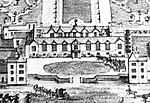Aldersbrook Estate

The Aldersbrook Estate is the name given to an Edwardian housing estate in Aldersbrook, Wanstead, in the London Borough of Redbridge. The built-up area is surrounded on all sides by open space and parkland, including Wanstead Park, Wanstead Flats, Bush Wood and the City of London Cemetery and Crematorium. There are no public houses, except the bar of the Courtney Hotel, which is at the extreme south-eastern corner of the estate, something that may reflect the generally pro-temperance Edwardian era in which the estate was laid out, or was perhaps due to restrictive covenant. There is also a bowls club that has a small bar in it, located on Aldersbrook road. There is a school, Aldersbrook Primary School, a library on Park Road and two churches, the Anglican St Gabriel's and Aldersbrook Baptist Church. There is a short strip of shops on Aldersbrook Road, in the south-eastern corner of the estate, a convenience store in the western end of the estate, behind the Anglican church, and a launderette and another convenience store at the eastern side of the estate.
Excerpt from the Wikipedia article Aldersbrook Estate (License: CC BY-SA 3.0, Authors, Images).Aldersbrook Estate
Herongate Road, London Wanstead (London Borough of Redbridge)
Geographical coordinates (GPS) Address Nearby Places Show on map
Geographical coordinates (GPS)
| Latitude | Longitude |
|---|---|
| N 51.5629 ° | E 0.0375 ° |
Address
Herongate Road
E12 5DY London, Wanstead (London Borough of Redbridge)
England, United Kingdom
Open on Google Maps








